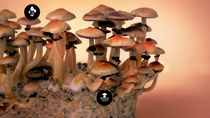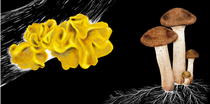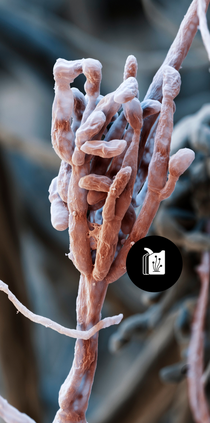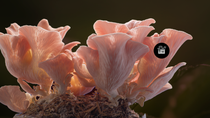“To transition away from fossil raw materials, we need to tap the potential
of fungi.”
Professor Vera Meyer,
Head of the Applied and Molecular Microbiology department at Technische Universität Berlin
Media
Fungi – they can be extremely small or impressively large. They can live deep in the ocean or way up in the stratosphere. They can be delicious or deadly. And thanks to their sheer diversity, new uses for fungi are popping up everywhere – from sustainable construction to climate-neutral chemistry. It is time to shine a spotlight on these versatile and multitalented organisms.
The area surrounding the Chernobyl reactor in northern Ukraine was assumed to be completely contaminated. But in 1991, five years after the devastating nuclear accident, researchers discovered something astonishing: A black fungus had spread over the walls of the reactor’s interior. It was not just surviving there, it was absolutely thriving. The fungus – Cryptococcus neoformans – seemed to really love radioactivity. Scientists soon discovered why: The fungus contains high levels of the pigment melanin, which enables it to absorb radiation and transform it into chemical energy. Researchers are now investigating whether fungi with these properties can also protect astronauts from hazardous radiation in space.
Mood booster
Many species in the Deconica genus are known as “magic mushrooms.” The often cone-shaped fruit body of these fungi is rich in psilocybin, a hallucinogenic substance that recent findings show may help treat psychiatric diseases such as depression.
Innovation driver
Mycelium, fungi’s root-like web of filaments, not only provides nutrients for trees and plants, but can also serve as an innovative raw material. Researchers from ETH Zürich, for example, were able to produce a living robot skin from 3D-printed mycelium, which can regrow after being cut.
According to biotechnology professor Vera Meyer, fungi “have incredibly diverse metabolic capabilities.” Meyer is head of the Applied and Molecular Microbiology department at Technische Universität Berlin, and has been researching the world of fungi for more than 20 years. “It is their ability to adapt and change that I find so fascinating, including how they can switch between friend and foe.” There would be no life as we know it without mycelium, fungi’s root-like underground network of filaments, which delivers nutrients to trees and plants. Yet fungi can also damage organisms – by causing infections, for example. They come in many forms: from delicious, edible wild mushrooms on the forest floor to mold growing on an old piece of bread. And while a fungal spore may be as small as 2 to 10-thousandths of a millimeter, the Earth’s largest living organism is also a fungus: a specimen of Armillaria ostoyae in a U.S. national park whose mycelium stretches over an area of 9 square kilometers.
“To transition away from fossil raw materials, we need to tap the potential
of fungi.”
Professor Vera Meyer,
Head of the Applied and Molecular Microbiology department at Technische Universität Berlin
“Fungi are everywhere, and they are all-rounders,” Meyer explains. “They are masters of both decomposition and synthesis.” Using enzymes – in other words, biocatalysts – they can break down biogenic raw materials, such as wood or straw, into their components and then recombine and assemble these for a wide variety of products. Meyer and her team are bursting with ideas of how humans can take advantage of this. They are researching everything from fungi-based, sustainable bike helmets to clothing and packaging material. At the same time, she says, the many talents of fungi are also leading to a new wave of connection in the academic world. “The various scientific communities are now starting to communicate more intensively with each other,” says Meyer. Researchers who previously studied only fungal proteins or enzymes now understand that “fungi could also be used to produce sustainable construction materials.”
The possibilities in construction have also piqued Meyer’s interest. With her interdisciplinary collective MY-CO-X, which brings together artists, architects and biotechnologists, she created an inhabitable sculpture made of fungi and wood. The 20 square meter wooden structure called MY-CO SPACE is inspired by the design of a space capsule and is completely biodegradable. “The load-bearing components show the challenges facing fungal biotechnology: making materials durable and stable enough to compete with concrete,” Meyer says. To achieve this, the researcher relies on composite materials. The fungal mycelium is grown in agricultural and forestry residues, such as straw, bark or sawdust, or in concrete recycled from demolition waste. As it grows, it compresses the particles into a hard composite material. The network of fungal filaments grows increasingly dense, acting like mortar that binds the concrete pieces together. The new materials are to be produced with low CO2 emissions and be repeatedly recyclable.
Inflammation stopper
The jelly-like yellow brain fungus produces carbohydrates with anti-inflammatory effects, which medical researchers are keen to study. These might help to treat diabetes and allergies, stimulate the immune system and protect against radiation.
Water purifier
Melanin is in high demand in industry – and it costs more than gold! Researchers in Switzerland were able to obtain this pigment from the mullet honey fungus. Because melanin can bind heavy metals, it can be used to develop innovative water filters.
In her own artistic works, Meyer shows how mycelium material organically combines with other raw materials. Her fungi sculptures reflect the zeitgeist: In many areas – including the arts, pop culture, business and academia – there is growing excitement about the special characteristics and abilities of fungi. We are experiencing a real “mushroom boom.” Fungi expert Gordon Walker, a California based PhD biochemist, takes his more than one million social media followers on virtual strolls through the undergrowth. Mushrooms served as a muse for Icelandic artist Björk’s 2022 album, Fossora, while photographers are capturing the aesthetic beauty of fungi. And industry and academia are looking to harness fungal metabolism to help the climate – by using the organisms to produce substitute meat products or resource-saving materials, for example.
The talents of fungi also offer many opportunities for industry. “If we want to transition away from fossil raw materials to renewables, we need to tap the potential of fungi,” says Meyer. BASF is doing exactly that, putting the tiny organisms to work on a large scale. They feed on organic raw materials, such as sugar, and metabolize them into sustainable products. “This means they can replace chemical processes based on crude oil. Fungal biotechnology, along with bacterial and other processes, is therefore a key technology for us on the path towards climate-neutral chemistry,” says Dr. Doreen Schachtschabel, Vice President White Biotechnology Research at BASF. Industrial biotechnology – also called white biotechnology – is poised to grow faster than the conventional chemicals business in the coming years. BASF’s portfolio already contains about 3,000 biotechnology-based or biodegradable products.These range from flavors and fragrances to crop protection products.
“Fungi are particularly interesting for BASF, as the desired traits can basically be genetically inscribed – making them into efficient cell factories for industrial applications,” says Dr. Stefan Haefner, industrial biotechnology expert at BASF. One promising microorganism is called Ashbya gossypii. In its conventional form, this fungus attacks tomatoes, hazelnuts and lemons. But in a genetically modified form, Ashbya gossypii becomes a smart cell factory. BASF researchers have been able to modify this fungus in such a way that it can produce large volumes of vitamin B2 in a bioreactor, also known as a fermenter.
Vitamin B2, which is essential for human and animal nutrition, used to be chemically synthesized. This was a complex, seven-stage process that required various chemicals and ultimately produced a small yield. “We have replaced this with a simple one-step process,” says Dr. Birgit Hoff, project leader for industrial biotechnology at BASF. “We feed the fungus with plant-based oil, which it then converts into vitamin B2.” Compared to the chemical process, the biotechnology process requires one-quarter less energy, produces one-third less greenhouse gas, and is resource-efficient thanks to the renewable feedstock. “But fungi are complex systems,” stresses fungus expert Haefner. “Each one functions differently. Just because you are familiar with one and its metabolic pathways, you do not necessarily know the others.” And this is exactly what makes fungi so useful.
“Thanks to their almost inexhaustible possibilities, they can be used to create an incredible variety of products.” However, much of this potential is still undiscovered: A research team from Berlin and London estimates there are somewhere between 2.2 and 3.8 million species of fungi, of which only 120,000 have been scientifically described so far. About 1,500 more are discovered every year. “At the same time, fungi – depending on their stage of development – display an amazing ability to change their appearance,” says biochemist Walker, citing the example of the yellow brain fungus: On dead wood, it forms glowing fruit bodies when it creates gametes. However, the same species can also reproduce asexually, through spores, and it then appears as yeast fungus.
Biofuel builder
“Mycodiesel” is what U.S. researcher Dr. Gary Strobel calls his concoction produced by a South American fungus when it is fed with cellulose. In the lab, the mushroom species Gliocladium roseum produced small volumes of non-fossil biofuel.
Another fungus that reproduces in yeast form is the one that grows by transforming Chernobyl’s radioactivity into chemical energy. “This is just one example of how fungi can be beneficial destroyers,” says Walker. Others can also break down plastics. Farmers use this to their advantage with mulch films made from BASF’s certified biodegradable polymer ecovio®. After the harvest, they simply plow the film under the soil, where microorganisms such as bacteria and fungi recognize the structure of the film and transform it into CO2, water and biomass – thereby returning the material into the natural cycle.
Walker is also fascinated by this cycle. If you observe fungal organisms, he points out, you recognize that there is no waste in nature – everything decomposes and is renewed in a veritable cycle. “Fungi are very talented and can help us to preserve an Earth worth living on,” Walker says.
“Fungi are very talented and can help us to preserve an Earth worth living on.”
Gordon Walker, PhD
Biochemist
Music maker
Artist MycoLyco uses mushrooms to create music. He connects pink oyster mushrooms or cordyceps to his synthesizer, making audible small electronic signals from inside the fungus.





